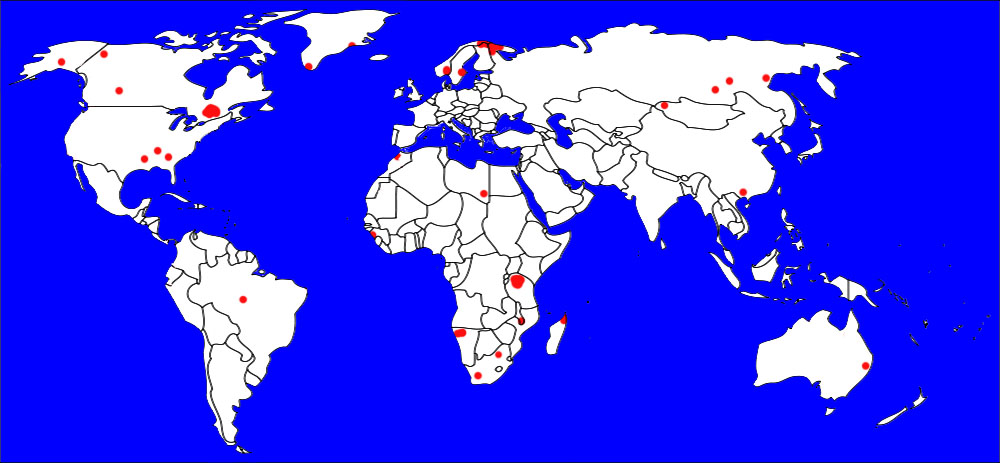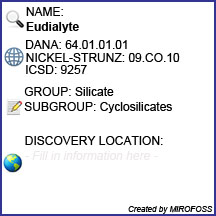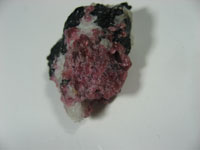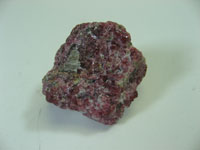![]()
Eudialyte is a somewhat rare red silicate mineral, which forms in alkaline igneous rocks, such as nepheline syenites. The name eudialyte is derived from the Greek phrase Εὖ διάλυτος eu dialytos, meaning "well decomposable", Its name alludes to its ready solubility in acid. Eudialyte was first described in 1819 for an occurrence in nepheline syenite of the Ilimaussaq intrusive complex of southwest Greenland. The rarity of eudialyte makes locality useful in its identification. Prominent localities of eudialyte include Mont Saint-Hilaire in Canada and the Kola Peninsula in Russia, but it is also found in Greenland, Norway, and Arkansas.
![]()
Within the metaphysical realm of minerals, eudialyte helps to spark ideas within the believer. Eudialyte brings the believer's heart and base chakras into alignment and to assist in following the path of joyous co-creation with all of reality. It allows for the believer's heart’s deepest desires to manifest in the physical world. It allows the things that the believer loves the most to become part of their everyday life, thus allowing for a more fulfilling life. Eudialyte increases the believer's energy and boosts confidence, self-expression and creativity. It helps the believer to overcome doubt, self-criticism, confusion and fear. Its energies support for the believer as they move in the direction of their dreams.
Please note that MIROFOSS does not suggest in any way that minerals should be used in place of proper medical and psychological care. This information is provided here as a reference only.
![]() Eudialyte is used as a minor ore of zirconium. Another use of eudialyte is as a minor gemstone, but this use is limited by its rarity, which is compounded by its poor crystal habit. These factors make eudialyte of primary interest as a collector's mineral.
Eudialyte is used as a minor ore of zirconium. Another use of eudialyte is as a minor gemstone, but this use is limited by its rarity, which is compounded by its poor crystal habit. These factors make eudialyte of primary interest as a collector's mineral.
![]()
Eudialyte can be found in nepheline syenites and alkalic granites.
![]()
Eudialyte is found associated with other alkalic igneous minerals, in addition to the some minerals common to most igneous material in general. Associate minerals include: microcline, nepheline, aegirine, lamprophyllite, lorenzenite, murmanite, arfvedsonite, sodalite, aenigmatite, rinkite, låvenite, titanite and titanian magnetite. The lack of crystal habit, and the mineral colour, are useful when identifying eudialyte as well as the associated minerals that can be found near eudialyte. A pink-red mineral with imperfect crystals associated with other alkaline igneous material, especially nepheline and aegirine, is a good indication a specimen is eudialyte.
![]()
| Cleavage | Imperfect | |
| Colour(s) | Pinkish red, Red, Yellow, Yellowish brown, Violet | |
| Specific Gravity | 2.9 | |
| Diaphaneity | Transparent to Translucent | |
| Fracture | Uneven - Flat surfaces (not cleavage) fractured in an uneven pattern | |
| Mohs Hardness | 5.0 to 5.5 | |
| Luminescence | Non-fluorescent | |
| Lustre | Vitreous | |
| Streak | White | |
| Habit(s) | Massive to Granular to Tabular | |
| Radioactivity | Eudialyte per GRapi unit = 137.21 (PPM) | |
| Magnetism | Non-magnetic |
![]()
The following health hazards should be noted when handling eudialyte
 |
RADIOACTIVE Eudialyte is radioactive as defined in section 49 CFR 173.403. Greater than 70 Bq / gram. Eudialyte is considered moderately radioactive. |
![]()
The following image shows the Elemental breakdown of the mineral eudialyte along with the mineral crystal structure.

![]()
| Crystal System | Trigonal |  |
| Class | Hexagonal | |
| Axial Ratios | a : c = 1 : 2.10669 | |
| Twinning | short rhombohedral to long prismatic | |
| Optical Data Type | Uniaxial (+/-) | |
| Pleochroism (x) | N/A | |
| Pleochroism (y) | N/A | |
| Pleochroism (z) | None |  |
| RL Values | nω = 1.606 - 1.610 nε = 1.610 - 1.613 | |
| 2V | N/A | |
| Max Birefringence | δ = 0.004 (See colour chart at right) | |
| Surface Relief | Moderate | |
| Dispersion | Weak |
![]()
Eudialyte can be referenced in certain current and historical texts under the following five names:
The mineral eudialyte can be translated into the following select languages:
| Arabic | Bulgarian | Chinese (Sim) | |||
| Croatian | Czech | Danish | eudialyt | ||
| Dutch | Eudialyt | Esperanto | Estonian | eudialiit | |
| Finnish | French | German | Eudialyt | ||
| Greek | Hebrew | Hungarian | |||
| Italian | Japanese | ユージアライト | Korean | 유마일라읻으 | |
| Latin | Lithuanian | Norwegian | |||
| Persian | Polish | Portuguese | |||
| Romanian | Russian | Эвдиалит | Slovak | ||
| Spanish | Eudalita | Swedish | eudialyt | Tagalog | |
| Turkish | Ukrainian | Евдіалітia | Vietnamese |
![]()
Eudialyte can be found in only a very limited number of places around the world. The map below shows major documented concentrations of eudialyte:

![]()
 |
The MIROFOSS database offers free printable geological identification tags for personal and non-profit use. These tags can be used to properly identify mineral samples in your collection. -Click here- to download a full size jpeg image for a eudialyte identification tag; which can be printed on paper or used with a plastic laser printer. |
 |
What's this? What can I do with it? |
![]()
| Crystallography | Khomyakov, A.P., Nechelyustov, G.N., Rastsvetaeva, R.K. (2007): Aqualite, (H3O)8(Na,K,Sr)5Ca6Zr3Si26O66(OH)9Cl, a new eudialyte-group mineral from Inagli alkaline massif (Sakha-Yakutia,Russia),and the problem of oxonium in hydrated eudialytes. Proceedings of the Russian Mineralogical Society (Zapiski RMO), 136(2), 39-55. |
| History | Canadian Mineralogist (1999): 37: 865-891. |
| Chemical Composition | Johnsen, O. and Galt, R.A. (1997) Chemical variation in eudialyte. Neues Jahrbuch für Mineralogie, Abhandlungen: 171: 215-237. |
| Geographical Data | Mindat.org. Retrieved on 2012-11-01 |
| Physical Identification | Webmineral.com. Retrieved on 2012-11-01 |
| November 01, 2012 | The last time this page was updated |
| ©2017 MIROFOSS™ Foundation | |
 |
|







